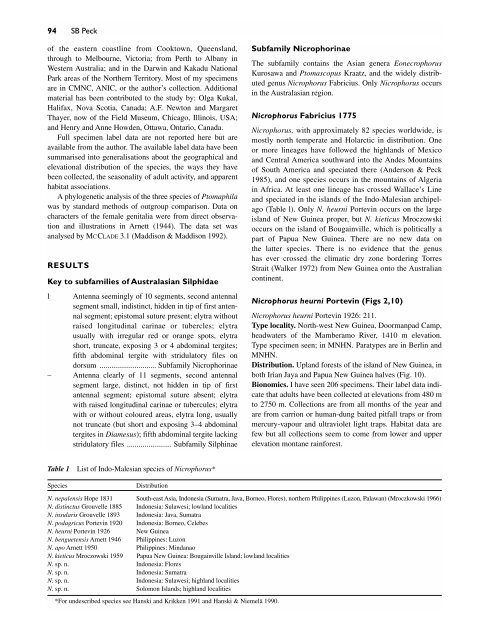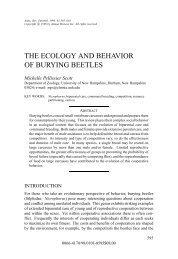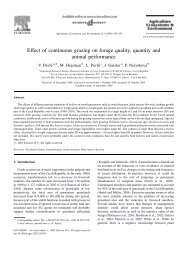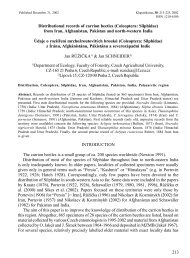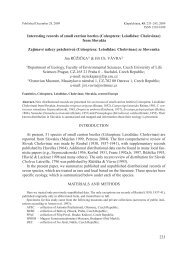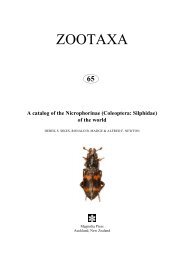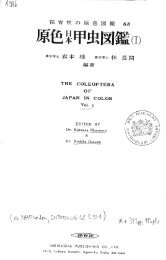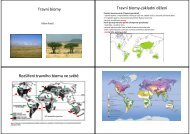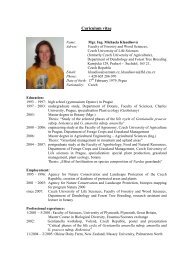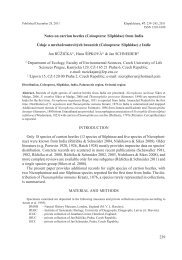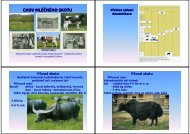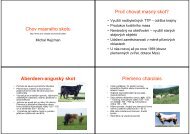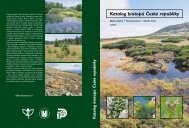Review of the carrion beetles of Australia and New Guinea ...
Review of the carrion beetles of Australia and New Guinea ...
Review of the carrion beetles of Australia and New Guinea ...
You also want an ePaper? Increase the reach of your titles
YUMPU automatically turns print PDFs into web optimized ePapers that Google loves.
94 SB Peck<br />
<strong>of</strong> <strong>the</strong> eastern coastline from Cooktown, Queensl<strong>and</strong>,<br />
through to Melbourne, Victoria; from Perth to Albany in<br />
Western <strong>Australia</strong>; <strong>and</strong> in <strong>the</strong> Darwin <strong>and</strong> Kakadu National<br />
Park areas <strong>of</strong> <strong>the</strong> Nor<strong>the</strong>rn Territory. Most <strong>of</strong> my specimens<br />
are in CMNC, ANIC, or <strong>the</strong> author’s collection. Additional<br />
material has been contributed to <strong>the</strong> study by: Olga Kukal,<br />
Halifax, Nova Scotia, Canada; A.F. <strong>New</strong>ton <strong>and</strong> Margaret<br />
Thayer, now <strong>of</strong> <strong>the</strong> Field Museum, Chicago, Illinois, USA;<br />
<strong>and</strong> Henry <strong>and</strong> Anne Howden, Ottawa, Ontario, Canada.<br />
Full specimen label data are not reported here but are<br />
available from <strong>the</strong> author. The available label data have been<br />
summarised into generalisations about <strong>the</strong> geographical <strong>and</strong><br />
elevational distribution <strong>of</strong> <strong>the</strong> species, <strong>the</strong> ways <strong>the</strong>y have<br />
been collected, <strong>the</strong> seasonality <strong>of</strong> adult activity, <strong>and</strong> apparent<br />
habitat associations.<br />
A phylogenetic analysis <strong>of</strong> <strong>the</strong> three species <strong>of</strong> Ptomaphila<br />
was by st<strong>and</strong>ard methods <strong>of</strong> outgroup comparison. Data on<br />
characters <strong>of</strong> <strong>the</strong> female genitalia were from direct observation<br />
<strong>and</strong> illustrations in Arnett (1944). The data set was<br />
analysed by MCCLADE 3.1 (Maddison & Maddison 1992).<br />
RESULTS<br />
Key to subfamilies <strong>of</strong> Australasian Silphidae<br />
l Antenna seemingly <strong>of</strong> 10 segments, second antennal<br />
segment small, indistinct, hidden in tip <strong>of</strong> first antennal<br />
segment; epistomal suture present; elytra without<br />
raised longitudinal carinae or tubercles; elytra<br />
usually with irregular red or orange spots, elytra<br />
short, truncate, exposing 3 or 4 abdominal tergites;<br />
fifth abdominal tergite with stridulatory files on<br />
dorsum ............................. Subfamily Nicrophorinae<br />
– Antenna clearly <strong>of</strong> 11 segments, second antennal<br />
segment large, distinct, not hidden in tip <strong>of</strong> first<br />
antennal segment; epistomal suture absent; elytra<br />
with raised longitudinal carinae or tubercules; elytra<br />
with or without coloured areas, elytra long, usually<br />
not truncate (but short <strong>and</strong> exposing 3–4 abdominal<br />
tergites in Diamesus); fifth abdominal tergite lacking<br />
stridulatory files ....................... Subfamily Silphinae<br />
Subfamily Nicrophorinae<br />
The subfamily contains <strong>the</strong> Asian genera Eonecrophorus<br />
Kurosawa <strong>and</strong> Ptomascopus Kraatz, <strong>and</strong> <strong>the</strong> widely distributed<br />
genus Nicrophorus Fabricius. Only Nicrophorus occurs<br />
in <strong>the</strong> Australasian region.<br />
Nicrophorus Fabricius 1775<br />
Nicrophorus, with approximately 82 species worldwide, is<br />
mostly north temperate <strong>and</strong> Holarctic in distribution. One<br />
or more lineages have followed <strong>the</strong> highl<strong>and</strong>s <strong>of</strong> Mexico<br />
<strong>and</strong> Central America southward into <strong>the</strong> Andes Mountains<br />
<strong>of</strong> South America <strong>and</strong> speciated <strong>the</strong>re (Anderson & Peck<br />
1985), <strong>and</strong> one species occurs in <strong>the</strong> mountains <strong>of</strong> Algeria<br />
in Africa. At least one lineage has crossed Wallace’s Line<br />
<strong>and</strong> speciated in <strong>the</strong> isl<strong>and</strong>s <strong>of</strong> <strong>the</strong> Indo-Malesian archipelago<br />
(Table l). Only N. heurni Portevin occurs on <strong>the</strong> large<br />
isl<strong>and</strong> <strong>of</strong> <strong>New</strong> <strong>Guinea</strong> proper, but N. kieticus Mroczowski<br />
occurs on <strong>the</strong> isl<strong>and</strong> <strong>of</strong> Bougainville, which is politically a<br />
part <strong>of</strong> Papua <strong>New</strong> <strong>Guinea</strong>. There are no new data on<br />
<strong>the</strong> latter species. There is no evidence that <strong>the</strong> genus<br />
has ever crossed <strong>the</strong> climatic dry zone bordering Torres<br />
Strait (Walker 1972) from <strong>New</strong> <strong>Guinea</strong> onto <strong>the</strong> <strong>Australia</strong>n<br />
continent.<br />
Nicrophorus heurni Portevin (Figs 2,10)<br />
Nicrophorus heurni Portevin 1926: 211.<br />
Type locality. North-west <strong>New</strong> <strong>Guinea</strong>, Doormanpad Camp,<br />
headwaters <strong>of</strong> <strong>the</strong> Mamberamo River, 1410 m elevation.<br />
Type specimen seen; in MNHN. Paratypes are in Berlin <strong>and</strong><br />
MNHN.<br />
Distribution. Upl<strong>and</strong> forests <strong>of</strong> <strong>the</strong> isl<strong>and</strong> <strong>of</strong> <strong>New</strong> <strong>Guinea</strong>, in<br />
both Irian Jaya <strong>and</strong> Papua <strong>New</strong> <strong>Guinea</strong> halves (Fig. 10).<br />
Bionomics. I have seen 206 specimens. Their label data indicate<br />
that adults have been collected at elevations from 480 m<br />
to 2750 m. Collections are from all months <strong>of</strong> <strong>the</strong> year <strong>and</strong><br />
are from <strong>carrion</strong> or human-dung baited pitfall traps or from<br />
mercury-vapour <strong>and</strong> ultraviolet light traps. Habitat data are<br />
few but all collections seem to come from lower <strong>and</strong> upper<br />
elevation montane rainforest.<br />
Table 1<br />
List <strong>of</strong> Indo-Malesian species <strong>of</strong> Nicrophorus*<br />
Species<br />
Distribution<br />
N. nepalensis Hope 1831 South-east Asia, Indonesia (Sumatra, Java, Borneo, Flores), nor<strong>the</strong>rn Philippines (Luzon, Palawan) (Mroczkowski 1966)<br />
N. distinctus Grouvelle 1885 Indonesia: Sulawesi; lowl<strong>and</strong> localities<br />
N. insularis Grouvelle 1893 Indonesia: Java, Sumatra<br />
N. podagricus Portevin 1920 Indonesia: Borneo, Celebes<br />
N. heurni Portevin 1926 <strong>New</strong> <strong>Guinea</strong><br />
N. benguetensis Arnett 1946 Philippines: Luzon<br />
N. apo Arnett 1950 Philippines: Mindanao<br />
N. kieticus Mroczowski 1959 Papua <strong>New</strong> <strong>Guinea</strong>: Bougainville Isl<strong>and</strong>; lowl<strong>and</strong> localities<br />
N. sp. n. Indonesia: Flores<br />
N. sp. n. Indonesia: Sumatra<br />
N. sp. n. Indonesia: Sulawesi; highl<strong>and</strong> localities<br />
N. sp. n. Solomon Isl<strong>and</strong>s; highl<strong>and</strong> localities<br />
*For undescribed species see Hanski <strong>and</strong> Krikken 1991 <strong>and</strong> Hanski & Niemelä 1990.


